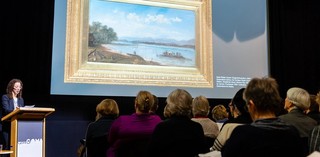A unique perspective on Australian Art

Across three Saturdays in July, QAGOMA hosted the Australian Art Course 2019. Presented by Angela Goddard, Director, Griffith University Art Museum, the course offered a thought-provoking look at aspects of Australian art history with QAGOMA’s Australian Art Collection as a guide and point of departure.
Goddard offered a unique perspective on the Collection, exploring the compelling and often complex history of Australian art. The course drew on a selection of iconic artworks from the Australian Art Collection currently on display, from historic works by Arthur Streeton, Godfrey Rivers and Eugéne Von Guérard, to contemporary works by Richard Bell, Kerrie Poliness and D Harding.
Throughout the course artists’ voices were also highlighted through a series of Q&As featuring Kinly Grey, Anne Wallace and D Harding.
Landscape and country
‘Landscape and Country’ considered the landscape in Australian art, exploring relationships to place and the environment. From ancient Indigenous rock art, through documents made by colonial settlers and European artistic traditions, to contemporary art.
This session featured a Q&A with artist Kinly Grey. Grey is an experiential artist working in Brisbane. They engage sensory experience and expanded poetics to explore art as affect. With audience experience at the centre of their practice, Grey’s works often require active participation by viewers to be realised.
The twentieth Century
‘The twentieth Century’ explored modernism in Australia, as well as tracing a history of the body as subject and medium in art.
This session featured a Q&A with artist Anne Wallace. Wallace’s paintings explore people’s obsessions and the bizarre nature of everyday life. A sense of menace and foreboding often underlies her works. Portrait of Sue Treweek and Passing the River at Woogaroo Reach are on display at the Gallery of Modern Art (GOMA), entrance level.
The contemporary Moment
‘The contemporary Moment’ considered definitions of contemporary art, discussing parallel art histories as well as the development of contemporary Indigenous Australian art.
This session featured a Q&A via Skype with artist D Harding. Harding is a descendant of the Bidjara, Ghungalu and Garingbal peoples of central Queensland. His practice is informed by this heritage, in terms of both an oral history tradition and the artistic techniques he has inherited. See Wall Composition in Reckitt’s Blue 2017 in the Australian Collection at the Queensland Art Gallery (QAG) and Body of Objects 2017 as part of the exhibition ‘I, Object’ at the Gallery of Modern Art (GOMA) until 21 June 2020.
Feature image detail: Angela Goddard presenting the ‘Australian Art Course’ in 2019

